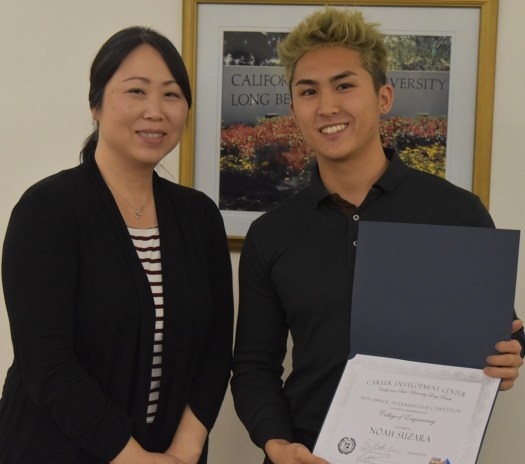Mechanical Engineering Student Wins University Internship Essay Contest

Mechanical engineering major Noah Suzara describes himself as a self-starter. When he landed an interview for a cost engineering internship at Jacobs Engineering, he didn’t know the first thing about cost engineering.
“I had no idea what cost engineering was before my interview. I had to read up on it,” said Suzara, who was immediately hired and put to work on a $40-million Shell refinery project in Martinez, California. After that project, he rotated to others, making contacts and becoming a self-described “Swiss Army knife” during his two years as an intern with the company.
“I just thrived over there,” he said. “I was learning things that are totally new to me. I learned that project controls were essential. I saw how project managers worked with the project. I learned how to communicate with clients. I learned how different types of engineers work together to fulfill project requirements and how project lifecycles work.”
Being a self-starter inspired him to work on his public speaking skills. He joined a Toastmasters group called Jacobs Jabbers. In 2018, he entered an office-wide speech contest and spoke about one of his biggest passions: space exploration. “I talked about a JPL project—the Curiosity Rover. Everyone needs to keep being curious. You don’t learn anything without asking questions. Some are easy, some are a bit more difficult. Others are almost impossible to know, like what the inside of a black hole looks like – physical laws prohibit us to view that,” Suzara said.
To his surprise, he won, beating out a handful of more experienced public speakers. He credits the win to his enthusiasm, and to hours of practice. This past summer, Suzara had another chance to pursue his interest in space exploration—with a cost engineering internship at NASA’s Jet Propulsion Laboratory in Pasadena.
He’s been interested in space his entire life. “I have a lot of books. I have stickers of astronauts. I knew all the planets before kindergarten. My dream was to become an astronaut,” said Suzara, who advanced his knowledge by watching YouTube videos.
He almost didn’t apply because he was tiring of cost engineering. But an internship at JPL was too exciting of an opportunity to pass up. He was working at Jacobs when the interview request hit his Inbox. And over the next week, Suzara wrote down his STAR questions and a laundry list of other questions he may be asked during the phone interview.
At the end of the JPL phone interview, Suzara had the promise of an offer letter. “I walked outside and had goosebumps for 20 minutes. I was just overwhelmed to be getting my foot in the door of the space program. It’s not easy. I knew at that moment, that a dream had come true.”
This year, Suzara shared his JPL experience by entering the CSULB Internship Essay contest. He’d applied for it the year before and gotten nowhere. But this time, his essay was selected as the top one for the College of Engineering. And at the reception ceremony, it was selected as the top essay universitywide. The wins each come with a $500 scholarship.
“I was surprised to win the College of Engineering contest because my fellow students had some awesome internships, such as Boeing and Northrop Grumman. But that was absolutely incredible to win a universitywide contest,” he said.
Never having visited JPL before his orientation day, Suzara took the tour and was blown away to be inside buildings where so many historic space exploration vehicles had been designed, built, and operated. It was awe-inspiring to understand that the only high-definition pictures of Uranus and Neptune he’d seen were gathered by their only visitor, Voyager 2, which was built at JPL in the Spacecraft Assembly Facility. Every time he had a chance, he stopped by to watch progress on construction of the Mars 2020 rover.
“It’s incredible to think that someday we’re going to get to mars,” said Suzara. “I don’t know whether it will be in a couple of years or a couple of decades, but eventually we’ll get there”
During his internship, he helped refine the Cost Estimating and Methodology section of a proposal in response to an Announcement of Opportunity for NASA’s Discovery Program. The proposal, if selected, would be a Venus orbiting spacecraft called VERITAS. He also got to work on a personal project, in his case researching additive manufacturing in spacecraft design. He evaluated how 3D printing spacecraft parts could increase project benefits, including reducing the cost and schedule of projects with theoretical applications, producing a 24-page paper. Through these experiences, he learned how costs for spacecraft and spacecraft subsystems were modeled.
Suzara is still interested in space—and will be serving as a judge to name the next space exploration vehicle, the Mars 2020 rover–but would like to get experience doing engineering design after he graduates this semester.





